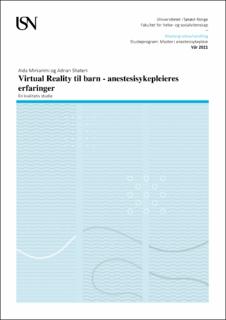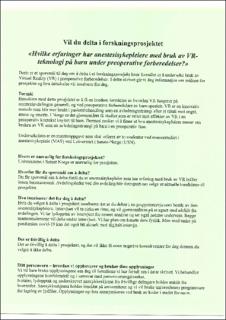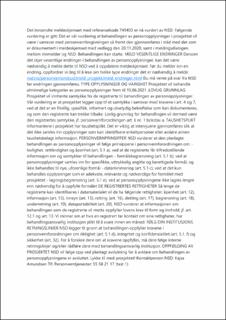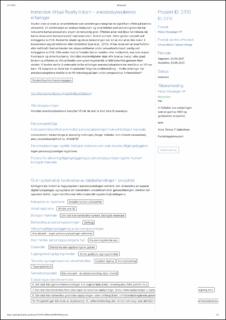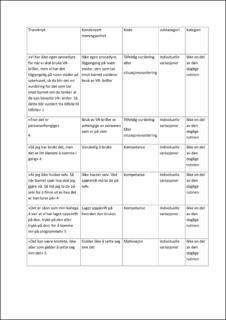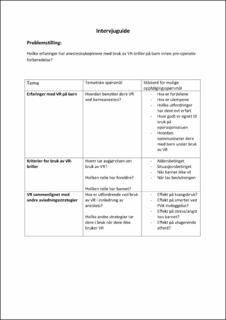| dc.contributor.advisor | Leonardsen, Ann-Chatrin Linqvist | |
| dc.contributor.author | Shateri, Adnan | |
| dc.contributor.author | Mirkarimi, Aida | |
| dc.date.accessioned | 2021-11-23T17:41:35Z | |
| dc.date.available | 2021-11-23T17:41:35Z | |
| dc.date.issued | 2021 | |
| dc.identifier | no.usn:wiseflow:2539282:41724589 | |
| dc.identifier.uri | https://hdl.handle.net/11250/2831102 | |
| dc.description.abstract | Problemstilling: Hvilke erfaringer har anestesisykepleiere med bruk av VR-briller på barn i forbindelse med preoperativ forberedelse?
Design: Denne studien er en kvalitativ studie, og det er gjennomført fokusgruppeintervju med fem anestesisykepleiere fra ulike operasjonsavdelinger på et sykehus i Norge.
Metode: Dataene er analysert ved hjelp av Graneheim og Lundeman (2004) sin beskrivelse av innholdsanalyse.
Resultater: Funn viste individuelle variasjoner i bruk av VR-briller som er basert på personalets kompetanse, motivasjon og ferdigheter. Tilrettelegginger i avdelingene og arbeidsmengde hadde også betydning for hvor ofte VR-brillene ble brukt. Deltagere hadde ulike erfaringer om effekten av VR-briller og rapporterte at de ikke alltid fungerte, spesielt hos svært engstelige barn. Det ble også nevnt at alder, barnets trygghet og tillit til helsepersonell, samt samspillet mellom barn og foreldre og mellom foreldre og helsepersonell hadde betydning for at VR-briller kunne fungere som en avledningsmetode.
Konklusjon: Anestesisykepleieres erfaringer viser at det er mer behov for opplæring av personalet både når det gjelder situasjonsvurdering og opplæring i VR-brillers funksjon. Anestesisykepleiere hadde varierte erfaringer om effekten av VR-briller. Anestesisykepleiere i møte med barn bør ha fokus på kommunikasjon og familiesentrert sykepleie i forbindelse med preoperative forberedelser.
Nøkkelord: Barn, pre-operativ angst og smerter, Virtual Reality, VR-briller, Anestesisykepleier, Foreldres tilstedeværelse | |
| dc.description.abstract | Issue: What experiences do anesthesia nurses have with the use of VR goggles on children in preoperative preparation?
Purpose: The purpose of this study is to analyze the anesthesia nurses experiences with the VR and their point of view about the effect and use of Virtual Reality on a preoperative context.
Design: A qualitative research. Data is collected through focus group interviews of five nurse anesthetists from different operating departments at a hospital in Norway.
Method: The data were analyzed using Graneheim and Lundeman's (2004) explanation of analyzing process.
Results: There were individual variations in the use of VR. The choice of VR was based on the staff´s competence, motivation and skills. While adaptation of the operating departments and work capacity had an impact on how often the VR goggles were used. Participants had different experiences about the effect of VR goggles and reported that didn’t always work, especially in very anxious children. It was also mentioned that age, the child’s safety and trust on health personnel as well as the interaction between the child and parents and between parents and health personnel were important for VR goggles to function as a distraction method.
Conclusion: The experience of the anesthesia nurses shows that there is a greater need for training of staff both in terms of situation assessment and training in the function of VR goggles. Anesthesia nurses had varied experiences about the effect of VR goggles. Anesthesia nurses in contact with children should focus on communication and family-centered nursing in preoperative preparations.
Keywords: Children, preoperative anxiety and pain, Virtual Reality, VR-goggles, anesthesia nurses, parental presence. | |
| dc.language | nob | |
| dc.publisher | University of South-Eastern Norway | |
| dc.title | Virtual Reality til barn - anestesisykepleieres erfaringer | |
| dc.type | Master thesis | |
